Need to prepare yourself for your next cold water swim session or triathlon?
Neoprene swim caps insulate and warm your head so that you perform the best of your ability.
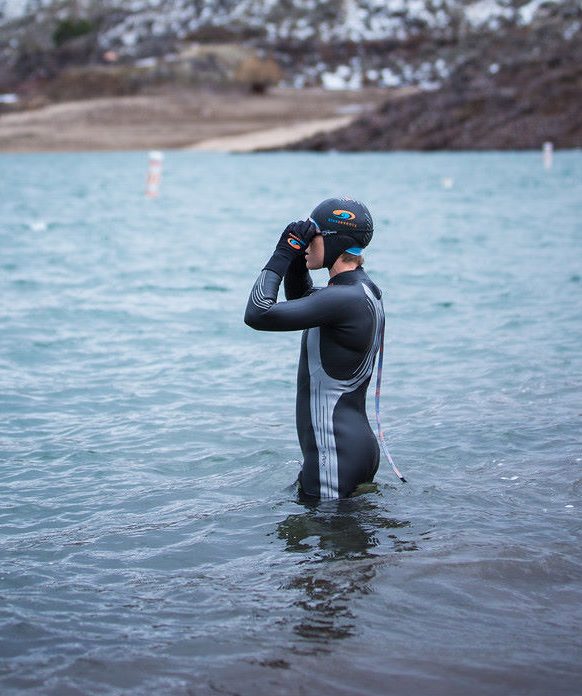
We’ve brought you the best neoprene swim caps along with some helpful pointers to guide you toward expert-level cold water swimming.
Best Neoprene Swim Caps for Cold Water Open Swimming in 2023
1. Blueseventy Thermal Neoprene Skull Cap
The Blueseventy skull offers superior heat retention thanks to its heat-trapping closed-cell 3 millimeters thick Yamamoto SCS-coated (Super Composite Skin) neoprene exterior and full-zirconium wool jersey lining.
The cap consists of two panels of expertly seamed neoprene. One stretches from the front to rear of the head and is stretchy, while the other securely covers the ears and chin.
The cap comes in three standard sizes and provides a secure and long-lasting fit. It fits swimmers with head circumferences as high as 22 to 24-inches. Some users found the Blueseventy’s chin strap to be irritating, though this is a common issue with neoprene caps.
It’s important to note that the Blueseventy cap is not capable of keeping your head dry.
Still, it helps users to retain a normal body temperature in waters well below 65 degrees Fahrenheit. Many users suggest wearing a silicone water cap over or under the neoprene cap to dramatically reduce water absorption and tame wild tresses.
Our Verdict
This is a reliable and well-fitted cap. It’s well suited for triathletes and other cold water swimmers. Blueseventy has utilized a dynamic combination of insulating fabrics. As such, the cap manages to keep heads warm and boost swimmer visibility in the most frigid bodies of water. Not to mention, the cap slides on and off with ease.
After testing this swimming hat out, we were not surprised to find that it is a top seller among triathletes.
2. ROKA Thermal Neoprene Swim Hood (with Strap)
The ROKA’s classic three-panel hood provides a secure fit for the most intensive swimmers. It features a 3 millimeter thick Yamamoto SCS-coated neoprene that has been glued and blind stitched for optimal durability. Further reinforcing its unbreakable seal, the ROKA features heat tape reinforced seams.
What’s more, the ROKU’s panels have been further improved with the use of an ultra-stretchy liner. This liner improves the cap’s ability to smoothly contour to a swimmer’s head.
The cap also features an integrated chin strap that holds it in place during rugged open swims and races. The cap comes in sizes, small/medium, medium/large, and large/extra-large. Finally, it is solid black and imprinted with the ROKA symbol on three sides.
Performance
The ROKA cap does a great job of insulating a swimmer’s head during intensive competitions. Unfortunately, it is not very visible. As such, swimmers should wear the cap under a high-visibility latex or silicone cap when training and racing in open water.
Still, the ROKA’s pliable liner enables it to slip on and off with ease. Not to mention, the chin strap secures the cap without cutting or chaffing a swimmers neck. Not to mention, it comes in a variety of sizes to accommodate different head sizes.
3. Zone3 Neoprene Swim Cap
If you’ve struggled to find a decent-fitting skull cap in the past, behold the Zone3, a neoprene swim cap with an adjustable Velcro strap.
The Zone3’s 4-millimeter Smoothskin neoprene panel retains heat in the most frigid waters. Not to mention, it caters to swimmers with varying head sizes. It also prevents the chin strap from choking swimmers, which is the most common complaint against one-piece swim caps.
Design
The Zone3 neoprene cap boasts a hydrodynamic design that helps swimmers improve their speed in the water. Not to mention, the cap’s closed yet adjustable panel creates a muted sound barrier around a swimmer’s head and ears. What’s more, the high friction exterior assists swimmers in retaining their goggles on when it matters most.
The cap features a sporty block panel with a red chin strap and accents. It also features the Zone3 logo on three sides. We found the cap to be easy to use, especially when it came to putting it on and taking it off. Our only issue is that the manufacturer fails to identify what thickness of neoprene is used to manufacture this cap. Still, this is an amazing accessory for anyone who spends an excessive amount of time in cold water.
4. Orca High-Visibility Neoprene Swim Cap
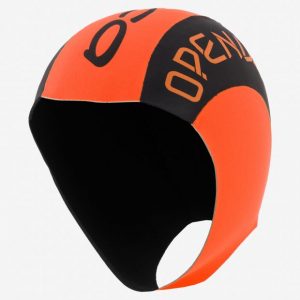
The Orca high-visibility swim cap is made from 100-percent premium neoprene. As such, it does a wonderful job of insulating and warming your skull during extensive cold water swims.
Meanwhile, its high-visibility orange color scheme is easy to see in all water conditions. The design features sporty front to back black and orange stripes. The cap comes in sizes small/medium and large/extra-large.
Fit
The Orca is a great swim cap, but it comes in limited sizes. In fact, the two available sizes run large, making it difficult to find the right fit. Of course, if you manage to nab a well-fitted cap, you’ll benefit from the Orca’s streamline fit and Smoothskin neoprene construction.
This is an ideal cap for swimmers navigating dangerous waters. The bright neon colorway makes it easy to spot in all water conditions. Just pair it with your favorite wetsuit and you’re guaranteed to maximize your body temperature.
5. Xterra Wetsuits Neoprene Swim Cap
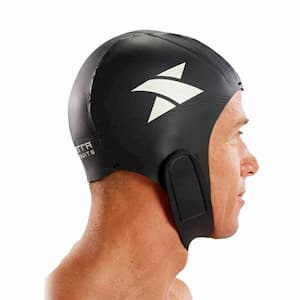
The Xterra Wetsuit neoprene swim cap keeps swimmers’ heads and ears 3 degrees warmer. It is made from 3-millimeter thick watertight neoprene. While traditional neoprene caps utilize a thin layer of water to keep your head warm, the Xterra keeps your head warm and dry by keeping water out. The cap is black with white logos. It fits snug and smooth, though the chin strap is slightly raised.
Fit
The Xterra neoprene swim cap boasts a soft flexible chin strap offers continuous comfort during rigorous water exercise. It comes in three sizes, including extra-small, small/medium, and large/extra-large. Still, the manufacturer claims the cap is one-size-fits-most, it’s important to pick a size that is well-suited for your head circumference.
We also appreciate that the Xterra;s 1-year warranty and 30-day money-back guarantee. If you’ve struggled to find a reliable cap in the past and want a risk-free option, the Xterra is a great choice.
6. TYR High-Visibility Neoprene Swim Cap
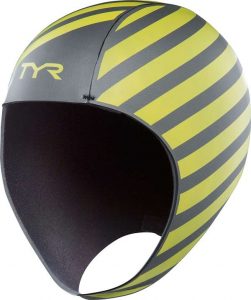
The TYR neoprene swim cap improves a swimmer’s safety in open water. The cap is made from premium 3-millimeter neoprene. It boasts a bright orange and yellow striped design that enhances a swimmer’s visibility in even the most adverse water conditions.
The Neoprene cap boasts a skin-tight fit that helps seal in warmth while protecting your hair and ears. It is also responsible for reducing drag. The cap has a built-in chinstrap and flexible central panel for creating the perfect fit on sizes of heads.
Performance
The TYR cap is a solid insulator in 50 to 60-degree water. It also has a strong grip that helps hold it in place choppy waters. On the downside, the chin strap is not adjustable. As such, some customers report that it irritates and chokes them. Of course, this is the number one complaint about one-piece neoprene caps and is, therefore, hard to avoid.
Neoprene Swim Caps – Buyer’s Guide
You’d be hard-pressed to find a professional triathlete who’s willing to take a plunge in cold water without their trusty neoprene cap. Read along to learn more about these heat-saving head covers and get all the answers to frequently asked questions/
Three Reasons Why You Should Use a Neoprene Swim Cap
1. Extend Your Training schedule
Don’t let seasonally cold water prevent you from training. Neoprene swim caps help swimmers endure harsh temperatures. Whether you are training in the San Francisco Bay or the English Channel, a neoprene swim cap will help you spend more time in the water and less time shivering on the shore.
2. Increase Your Visibility
Open water is substantially more dangerous than swimming in a pool. Unexpected hazards, like sharks, buoys, and boats, give many swimmers well-qualified anxiety. For this reason, most swimmers prefer to up their visibility by wearing a bright colorful hat or buoy. If open water gives you anxiety, consider purchasing a high-visibility neoprene cap that is easy to spot in all water conditions.
3. Improve Your Performance
Triathlon rules dictate that triathletes must wear a wetsuit in water that is below 57 degrees Fahrenheit. This is because there’s no natural or safe way for the body to acclimate to temperatures this low. Low temperatures can cause numbness, pain, rapid breathing, increased heart rate, and increased blood pressure. While a neoprene cap does not prevent the initial shock of cold water, it does insulate the body as it continues to adapt to cold water. It also prevents a substantial amount of heat from making a mass exodus from the body.
What to Consider Before Purchasing a Neoprene Swim Cap
Common latex swim caps are great for keeping your hair dry and out of your face, but they’re poorly suited for the demands of cold water open swims and triathlons. On the other hand, Neoprene swim caps provide insulated protection for individuals who train and compete in cold temperatures. That’s precisely why many triathletes and cold water swimmers choose to wear one during chilly open water expeditions.
Still not sure if a neoprene swim cap is right for you? Read along to learn about these cold water accessories.
Retain Heat
Cold water has a quick and intense effect on swimmers. In fact, exposure to temperatures below 60 degrees Fahrenheit can lead to rapid shock. In fact, prolonged exposure to cold water without proper protection can lead to hypothermia.
While someone said a false claim that humans lose the vast majority of heat through their heads, the reality is that humans only lose about 7-percent of heat through their noggins. In a recent study from the University of Manitoba, researches found that the body only looses around 10-percent of its heat through the head when submerged in cold water. Still, body heat drops significantly when the head is left to face the elements on its own. With that being said, there’s no better way to stay warm during cold water swims that to seal in the heat with a decent neoprene cap.
Hold on to Your Goggles
Many people choose to position their caps over the straps of their goggles. With the added security of the under-the-chin strap, a neoprene cap helps prevent googles from slipping off and sinking to the bottom of the ocean. Alternatively, some athletes choose to place their goggles over a neoprene cap. This prevents the goggles from pulling on your hair and makes them considerably more comfortable.
Reduce Distractions
Drag isn’t a major concern of open water swimmers nor does a neoprene cap prevent it. Still, long hair can be a major nuisance when paddling in deep water. A tightly fit neoprene cap keeps hair up and out of a swimmer’s face.
Acclimate Yourself
Athletes need to optimize their biological adaption to varying temperatures. Too much strain can lead to a number of adverse physical reactions. This is especially important when prepping for a competition. While repeated exposure to cold water helps reduce body’s shock, temperature-regulating accessories are the only finite way to extend the body’s biological limits.
How to Care for Your Swim Cap
Neoprene is a stretchy tight-fitting fabric that requires minimal maintenance. Read along to discover four helpful pointers for caring for and extending the longevity of your neoprene swim cap.
1. Rinse
Establish a habit of rinsing your cap with fresh cool water after each and every use. Chemicals, minerals, and additives can lead to the premature deterioration of neoprene fabric. A quick rinse will help purge these chemicals from the surface of your cap, giving it a better chance of retaining its tight fit, smooth surface, and elastic response. We recommend utilizing a strong, steady stream of water, such as a showerhead or hose, to effectively remove built-up from the surface of your skull cap.
2. Dry
Never toss a wet swim cap into a gear bag or locker without drying it first. We recommend hanging your cap in a well-ventilated area until all the residual liquid has evaporated. If you’re in a rush, use an absorbent towel to pat the surface dry. Wrap it in yet another dry towel and remove it from your gear bag as soon as humanly possible.
Never put your neoprene swim cap in the dryer This will cause it to break down and lose its elasticity.
3. Store it Properly
It’s tempting to hang swimming gear in the sun. However, the powerful UV rays of the sun will fade and weaken your cap. Instead, keep it enclosed in your gear bag, preferably in a compartment of its own.
4. Deep Clean.
Add a small amount of wetsuit cleaner or mild detergent to a tub of cool water and mix thoroughly. Submerge your cap fully. Allow it to soak for several minutes or, if needed, overnight. Using soft repetitive strokes, rub the interior and exterior of the cap. Rinse thoroughly to remove all residue.
Frequently Asked Questions
1. Do neoprene swim caps keep your hair dry?
No. Neoprene is a close-cell synthetic-rubber material that is commonly used in wetsuits. It insulates the body by trapping a thin layer of water within its skin-tight barrier. Your body quickly heats this thin layer of water until it is nearly as warm as your normal body temperature. With nowhere to go, the water insulates your body for an extended period of time.
2. Does neoprene come in varying thicknesses?
Yes. Neoprene comes in varying thicknesses. Neoprene thicknesses is measured in millimeters. Thick neoprene is best for keeping warm. Meanwhile, thin neoprene is ideal for flexibility. With that said, most manufacturers utilize neoprene that measures between 2 and 4 millimeters. The International Triathlon Union does no permit neoprene thicker than 5 millimeters.
3. Should I consider the temperature of the water I swim in when purchasing a neoprene swim cap?
Absolutely! The colder the water you plan to swim in the thicker the neoprene you should seek. For example, 3 and 4-millimeter neoprene is best suited for water below 63 degrees. Keep in mind that wetsuits and neoprene caps are not permitted in waters great than 72 degrees Fahrenheit.
4. How do I know what size swim cap to purchase?
A swim cap should form a snug fit over your head, ears, and chin. It should not allow water to flow freely within its walls. Most manufacturers sell a variety of cap sizes that are suited for people with specific head circumferences. On the other hand, some manufacturers sell one-size-fits-all caps with adjustable chin straps.
5. How do I measure my head circumference?
Wrap a flexible tape measure around the widest circumference point on your head. Do your best to include your hair in the measurement. Keep in mind that most manufacturers sell caps that fit a small range of head circumferences.
6. Why do some neoprene caps have internal liners?
Some manufacturers utilize thermal liners for added insulation and reduced water absorption. Wool fleece is a popular liner choice as it is extremely durable and retains heat well.
7. Why are some neoprene caps coated in protective materials
Many caps feature a water-resistant exterior coating. Yamamoto SCS is one popular material that is applied over the closed cells of neoprene. This material helps reduce the surface resistance of neoprene when it comes in contact with water.
Final Thoughts
A quality neoprene swim cap can make a cold water open swim or triathlon training more enjoyable and productive. After all, the human is only designed to handle so much abuse. Of course, once you experience the insulating effect of neoprene, you’ll probably want to pick up a pair of neoprene socks and gloves.
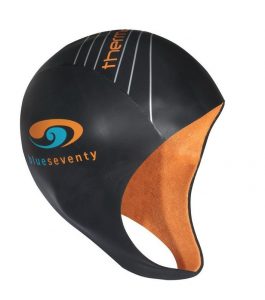
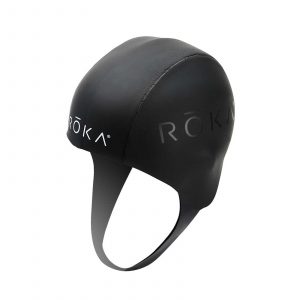
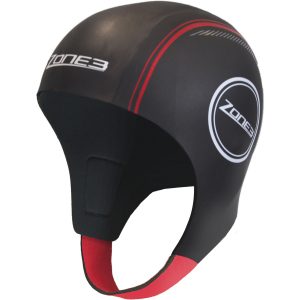
i have a blueseventy and it is great but coverage is inadequate. are any of these cut with a deeper coverage for front to back? i would love to find one that can cover from base of skull to the eyebrows.